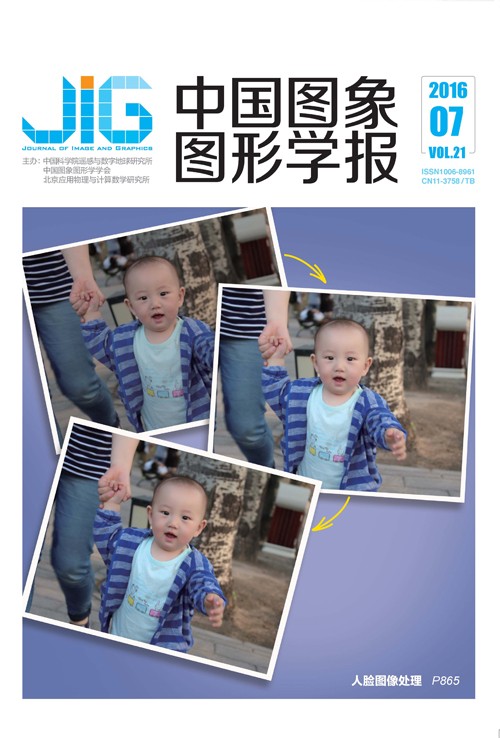
形状约束下活动轮廓模型冠脉血管图像多尺度分割
摘 要
目的 由于计算机断层血管造影(CTA)图像的复杂性,临床诊断冠脉疾病往往需要经验丰富的医师对冠状动脉进行手动分割,快速、准确自动分割出冠状动脉对提高冠脉疾病诊断效率具有重要意义。针对双源CT图像特点以及传统单一基于区域或边界的活动轮廓模型的不足,研究了心脏冠脉3维分割算法,提出一种基于血管形状约束的活动轮廓模型分割方法。方法 首先,利用改进的FCM(fuzzy C-means)对心脏CT图像感兴趣区域初分割,其结果用于初始化C-V模型水平集演化曲线及控制参数,提取感兴趣区域轮廓。接着,由3维心脏图像数据获取多尺度梯度矢量信息构造边界型能量泛函,然后利用基于Hessian矩阵的多尺度血管函数对心脏感兴趣区域3维体数据增强滤波,获取血管先验形状信息用于约束能量泛函。最后融合边界、区域能量泛函并利用变分原理及水平集方法得到适合冠脉血管分割的水平集演化方程。结果 由于血管图像的灰度不均匀,血管末端区域更为细小,所以上述算法的实施是面向被划分多个子区域的血管,在缩小的范围内进行轮廓的演化。相比于传统的血管分割方法,该方法充分融合血管图像的先验信息及梯度场信息,能够从灰度及造影剂分布不均匀的冠脉血管图像中准确分割出冠状动脉,对于细小的血管结构亦能获得较好的分割效果。实验结果表明,该方法只需在给定初始轮廓前提下,有效提取3维冠脉血管。结论 对多组心脏CT图像进行分割,本文基于血管先验形状约束的活动轮廓模型可以准确分割出冠脉结构完整轮廓,并且人工交互简单。该方法在双源CT冠脉图像自动分割方面具有较好的正确率与优越性。
关键词
Multi-scale segmentation of coronary artery image based on active contour model with shape constraints
Guo Xiaoyan, Mei Xue, Li Zhenhua, Cao Jiasong, Zhou Yu(College of Electrical Engineering & Control Science, Nanjing Tech University, Nanjing 211816, China) Abstract
Objective Owing to the complexity and randomness of CTA images in the clinic, clinicians are required to manually segment the coronary artery to diagnose a patient suffering from coronary artery diseases. How to segment the coronary artery quickly, accurately, and automatically is important for diagnostic efficiency. According to the features of dual-source CT image, a three-dimensional segmentation algorithm for cardiac coronary artery is investigated. To solve the difficulty of single region or boundary-based active contour model, the segmentation method of active contour model-based vessel prior shape is proposed. Method First, the improved fuzzy C-means algorithm is used for the initial coarse segmentation of the region of interest (ROI) in cardiac CT images to extract the ROI. The coarse segmentation result is applied to initialize the C-V model level set automatically and estimate the controlling parameters for level set evolution. Next, the 3D heart volume data are used to obtain multiscale gradient vector information and determine the structure of the boundary-based energy function. Then, the vascular structures within the 3D ROI volume are enhanced using the Hessian matrix-based multiscale vascular function. After vascular filtering, the vessel's prior shape information can be obtained to construct the region-based energy function. Finally, the boundary- and region-based energy functions are fused to construct the hybrid energy function, and the variation principle and level set method are used to derive the level set evolution equation for coronary vessel segmentation. Result The gray scales of vessel images are uneven, and the area of the terminal vessel is smaller than the others; thus, the aforementioned algorithm will be divided into several small-scale subareas of the vessels for the evolution of the contour. The vessel prior information and gradient information are fused to segment accurately the coronary artery from the image with uneven distribution of the gray and contrast agents, better than the conventional vessel segmentation method. Furthermore, good segmentation effect can further be obtained even for a small vessel structure. Experimental results show that the proposed method is only dependent on the initial contour to extract 3D vascular images effectively. Conclusion Several groups of heart volumes are tested to evaluate its performance in this study. The results show that active contour model-based vessel prior shape can accurately segment the complete coronary structures with a simple human interaction. The method has good accuracy and superiority in terms of the automatic segmentation of a dual-source CT coronary artery image.
Keywords
coronary artery segmentation cardiac CT image active contour model shape constraint level set method
|



 中国图象图形学报 │ 京ICP备05080539号-4 │ 本系统由
中国图象图形学报 │ 京ICP备05080539号-4 │ 本系统由